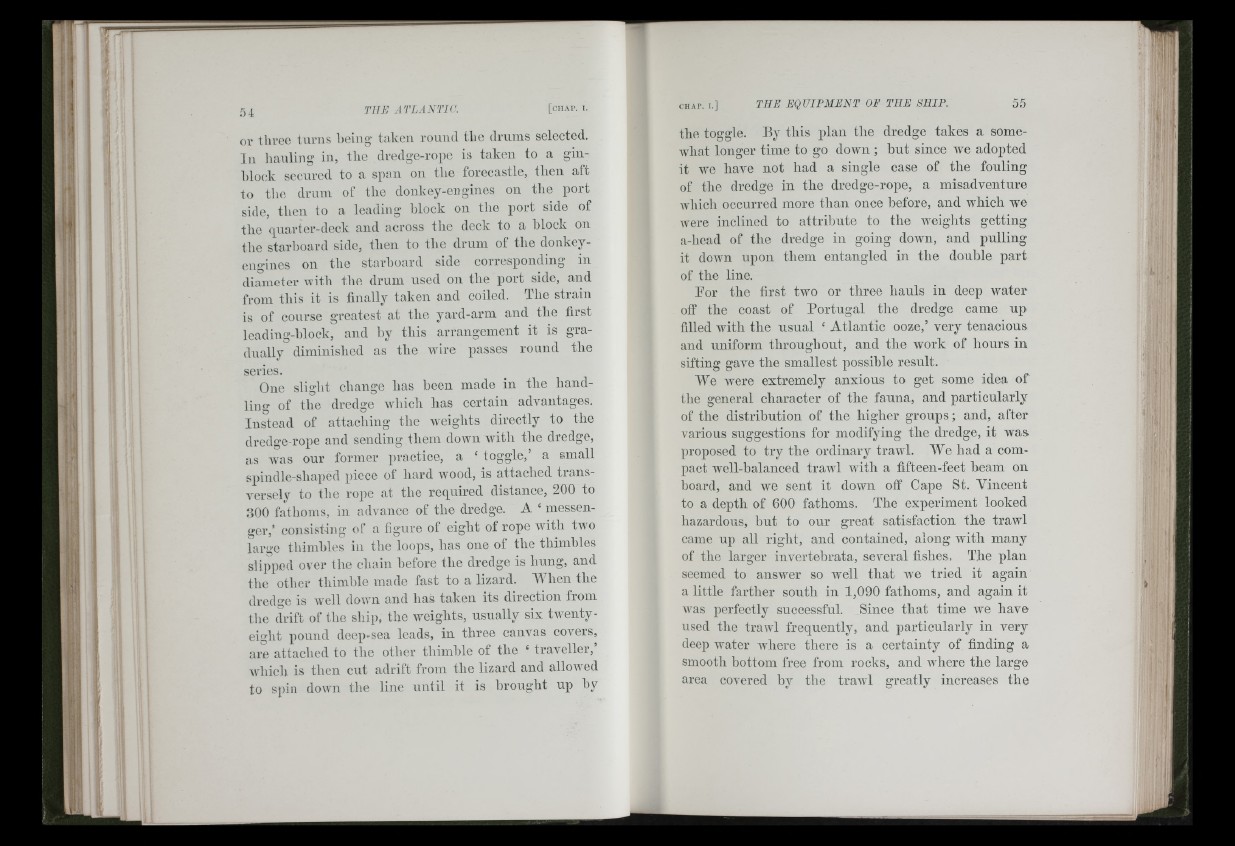
1
ov tliree turns being taken round tbe drums selected.
In lianliiig in, the dredge-rope is taken to a gim
l)lo(.‘k secured to a span on the forecastle, tlien aft
to the drum of the donkey-engines on the port
side, then to a leading block on the port side of
the quarter-deck and across the deck to a block on
the starboard side, then to tbe drum of tbe donkey-
engines on tbe starboard side corresponding in
diameter with tbe drum used on tbe port side, and
from tbis it is finally taken and coiled. Tbe strain
is of course greatest at the yard-arm and the first
Icadiug-hlock, and hy this arrangement it is gradually
diminished as the Avire passes round the
series.
One slight change has heen made in the handling
of the dredge AAdiich has certain advantages.
Instead of attaching the Aveights directly to the
dredge-rope and sending them down Avith the dredge,
as Avas our former practice, a ‘ toggle,’ a small
spindle-shaped piece of liard wood, is attached trans-
A’ersel^ to the rope at the required distance, 200 to
300 fathoms, in advance of the dredge. A ‘ messenger,’
consisting of a figure of eight of rope Avith tw’o
large tbimhles in the loops, has one of the thimbles
slipped over the chain before the dredge is hung, and
the otber tbimble made fast to a lizard. When the
dredge is Avell doAvn and has taken its direction from
the drift of the ship, the Aveights, usually six twenty-
eight pound deep-sea leads, in three canvas covers,
are attached to the other thimble of the ‘ traveller,’
Avhich is then cut adrift from the lizard and alloAved
to spill down the line until it is brought np hy
the toggle. Ily this plan the dredge takes a some-
Avhat longer time to go down ; b u t since Ave adopted
it Ave have not had a single case of the fouling
of the dredge in the dredge-rope, a misadventure
Avhich occurred more th an once before, and which we
Avere inclined to attrib u te to tbe Aveiglits getting
a-bead of the dredge in going doAvn, and pulling
it doAvn upon them entangled in the double part
of the line.
Tor the first two or three hauls in deep water
off the coast of Portugal the dredge came up
filled w’itli the usual ‘ Atlantic ooze,’ very tenacious
and uniform throughout, and the work of hours in
sifting gave the smallest possible result.
We were extremely anxious to get some idea of
the general character of the fauna, and particularly
of the distribution of the higher groups; and, after
various suggestions for modifying the dredge, it was
proposed to try the ordinary traAA’l. We had a compact
w’ell-balanced trawd Avith a fifteen-feet heam on
hoard, and we sent it down off Cape St. Vincent
to a depth of 600 fathoms. The experiment looked
hazardous, but to our great satisfaction the trawl
came up all right, and contained, along with many
of the larger invertebrata, several fishes. The plan
seemed to answer so well that Ave tried it again
a little farther south in 1,090 fathoms, and again it
Avas perfectly successful. Since that time we have
used the trawl frequently, and particularly in very
deep Avater where there is a certainty of finding a
smooth bottom free from rocks, and where the large
area covered hy the traAvl greatly increases the
s iniai